
Which Lift Is Right For Your Vehicle?
Body lifts and suspension lifts both offer a taller ride and room for larger wheels and tires, but they do have differences like cost, center of gravity and handling changes, and ground clearance. We’re going to take a look at some of these characteristics in-depth and hopefully give you a better idea of which lifting method you need.
Here is the “at a glance” version of the similarities and differences between body lifts and suspension lifts:
Comparison of Body Lifts and Suspension Lifts
| Lift | Cost | Larger Tires | Ride Height | Ground Clearance | Handling | Lift Size | DIY |
|---|---|---|---|---|---|---|---|
| Body Lift | Cheap | Possible | Increase | None | Factory Ride | 2 to 5 Inches | Easy-Moderate |
| Suspension Lift | Expensive | Possible | Increase | Increase | Body Roll Increase | 2 to 9 Inches | Difficult-Very Difficult* |
* Strut spacers are fairly easy to install and usually lift between 2-3 inches.
Lift Kits Defined
First it’s important to know what a body lift and a suspension lift actually do, and looking at the names it’s pretty simple: a body lift raises the body away from the frame and a suspension lift extends the suspension and raises every part of the vehicle. A leveling kit is basically a front suspension lift that raises the front suspension level with the rear in a vehicle with a raked stance, equalizing the height of the front and rear suspension.
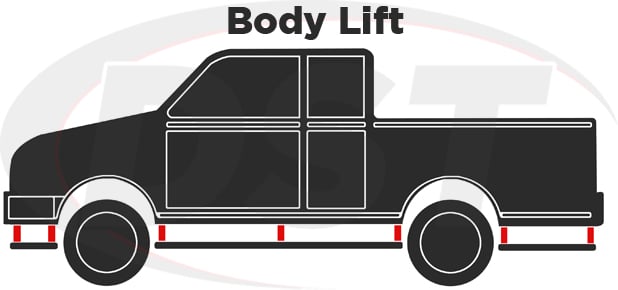
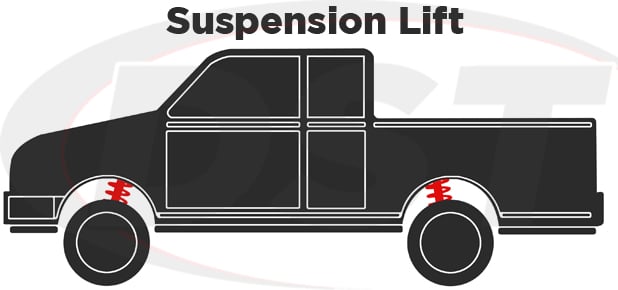
Body Lift VS Suspension Lift
Goals for Lifting your Vehicle
Before we dive deeper into the differences it’s important to decide what your goals are for lifting your truck or SUV. Do you want to install bigger tires? Do you want taller ride height? Do you want maximum ground clearance to push the limits of your vehicle’s offroad capabilities? There are lift kit options that will accomplish one or all of these goals, but they all have their trade-offs. Even with an unlimited budget just buying the biggest, most expensive lift kit is not always going to be the best option if you care about how your vehicle handles. So, if you have a good idea of what your goals are all that’s left is to consider the different options.
Cost:
If you’re asking “How much does it cost to lift my truck?” the answer is that it depends whether you’re talking about ride height or ground clearance. A body lift is the most inexpensive way to get ride height, but a suspension lift or bigger tires are your only options for more ground clearance.
If you’re modding on a budget then the total cost of accomplishing your lift is going to be a factor. In this area, body lifts are the best hands down. They are often simple kits of body blocks and usually do not require suspension or steering adjustment.
Leveling kits can be cheaper since they are often made up of just 2 strut spacers for the front Macpherson struts, but a full suspension lift is a complicated project that can include modifications to the steering, suspension, spindle and can easily double the price of a body lift of the same size. If larger wheels and tires are your ultimate goal then a body lift is going to be the cheapest option.
Install Cost:
As a side note body lift kits can usually be installed in a home garage making their total cost even lower. A full suspension lift kit can be a challenging install and require a shop and an experienced auto tech meaning you’ll have shop fees to add to your project’s cost.
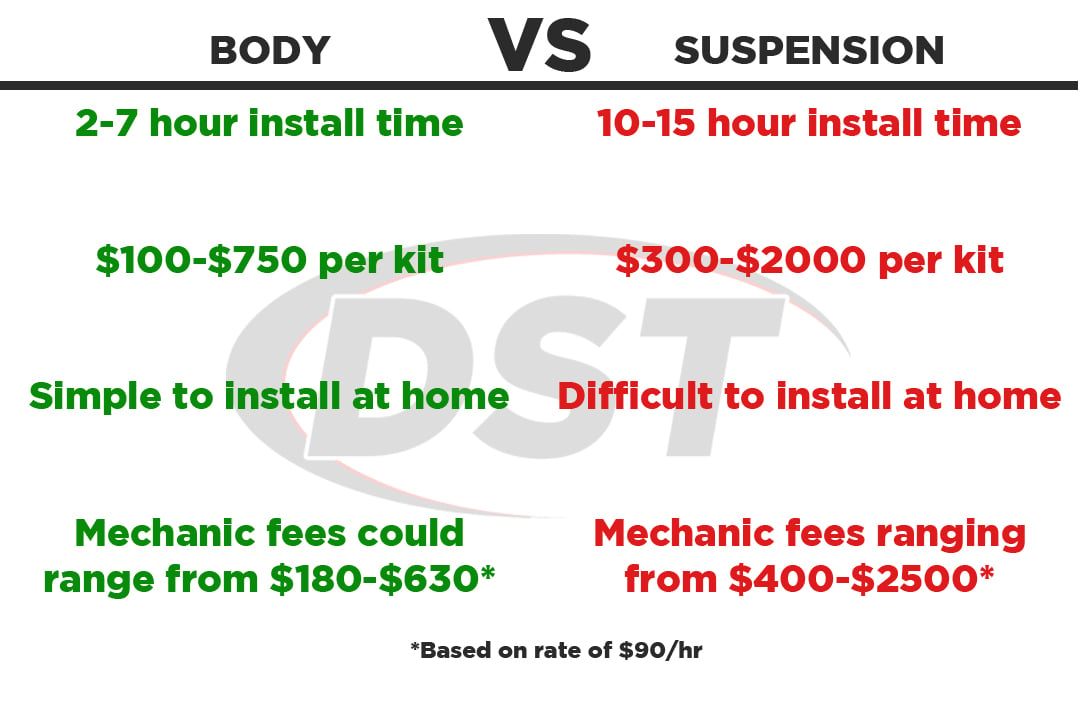
Ground Clearance:
No contest here – Suspension lift wins. Body lifts only raise the body so there is no change in the distance between the bottom of your vehicle and the ground. A suspension lift raises the frame of the vehicle (minus the axle and differential or lower control arms) so a 3 inch suspension lift nets you 3 inches of ground clearance. Leveling kits only raise the front suspension but since the front is the lowest point of the frame in a truck or SUV with a raked stance you will gain total ground clearance in the amount of the height of your leveling kit.
Lift Size:
If you want the tallest conceivable ride height then a suspension lift is going to be your go to. Theoretically, a body lift could be made that will give you a ridiculous amount of ride height but it would look, well, ridiculous. For most vehicles, 3 to 5 inches is the max for body lifts. Suspension lifts can soar up to 9 inches and beyond but these will be very expensive with broad changes to steering and suspension and are really all about serious rock crawling or the aesthetic of a sky-high truck or SUV. At extreme heights, even the most well-designed kits can not completely overcome the stability issues that a dramatically raised center of gravity imposes.
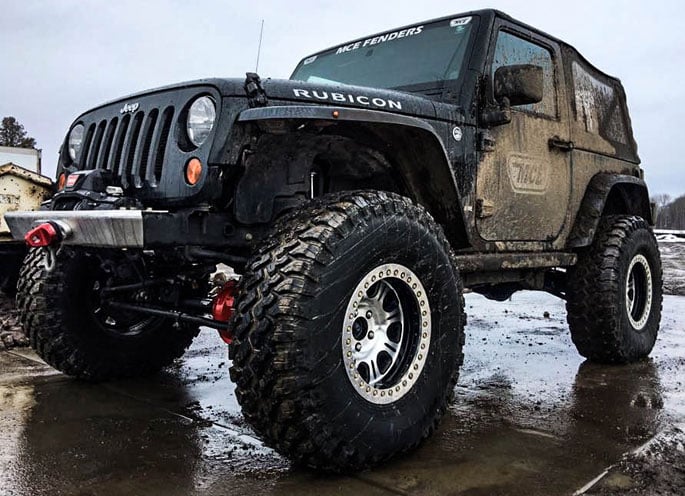
Handling:
There is a philosophy that is often quoted when it comes to lifting a vehicle – Lift as much as necessary, but as little as possible. This might seem like someone throwing a wet blanket over your dreams of installing a rope ladder to your cab but it’s really sound advice.
It has to do with your vehicle’s center of gravity. Every vehicle is engineered to handle at its best according to where the center of gravity of the vehicle is located. Every lifting method (including larger diameter tires) changes the center of gravity since the weight of the vehicle is being lifted. This means that you will experience more body roll during a turn since more weight is riding higher on the vehicle. This can affect stability during a hard quick turn as weight shifts to the outside.
Let’s look at how weight is generally distributed around a half-ton truck:
- 10% – Tires, Wheels, and Axles
- 20% – Body, along with all components inside of the body
- 70% – Frame, Engine, Transmission, and Drive Train
Center of Gravity:
Obviously increasing the tire size raises almost all vehicle weight and the center of gravity along with it, but only half as much as the tire diameter increase (3 inch tire increase = 1.5 inch center of gravity increase). A suspension lift also raises about 90% of the vehicle’s total weight increasing center of gravity almost as many inches as the lift size. Body lifts only raise 20% of the vehicle’s weight, giving you the lowest center of gravity increase of all the options and causing the least amount of change in how your vehicle handles.
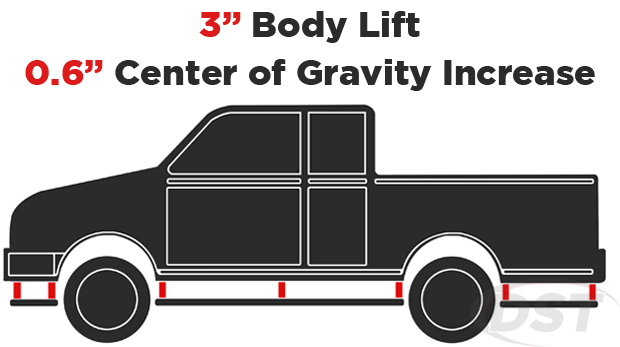
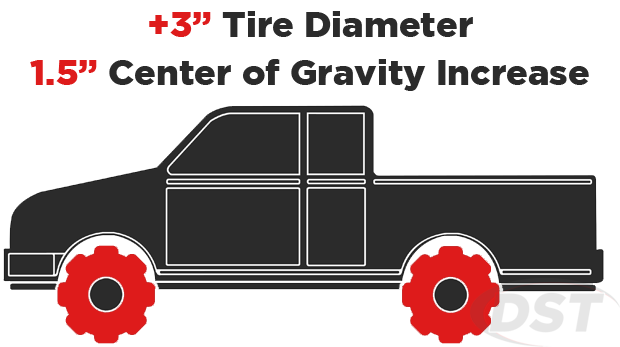
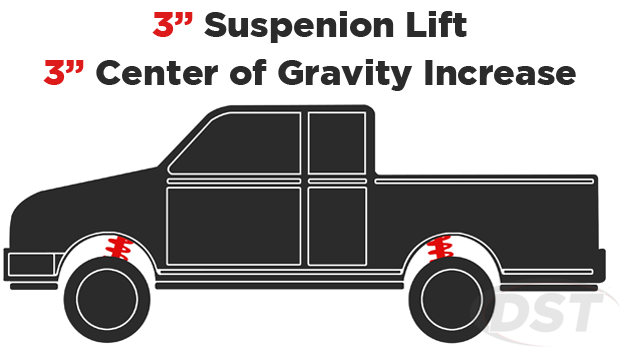
Here is a breakdown of how body lifts, suspension lifts, and bigger tires affect a vehicle’s center of gravity:
| Lift Type | Lift Size | Center of Gravity Increase |
|---|---|---|
| Body Lift | 3 inch lift | .60 inch |
| Wheels and Tires | 3 inch diameter increase | 1.5 inches |
| Suspension Lift | 3 inch lift | 3 inches |
Body and Suspension Lift Combo
It is possible to get the best of both worlds by stacking a body lift and a suspension lift. This is a great way to raise a vehicle and keep the handling characteristics of your truck or SUV intact. You can also get similar ground clearance increase by combining a suspension and body lift + bigger tires as you would with a full suspension lift – for about the same price.
Let’s say you wanted to lift your truck to achieve 4 inches of ground clearance and make room for 33 inch offroad tires. You could buy a 4 inch full suspension lift and have it installed at the shop, but a good quality kit is going to run you about $1,700 before installation fees so that may not leave much room in your budget for the tires that you want. Another option is combining a 2 inch lift and leveling kit with a 3 inch body lift kit, which is about half the price saving money for your 33 inch tires that will bring ground clearance up to about 3.5 inches. All this for about the same price plus less change to the factory suspension geometry and how your truck handles.
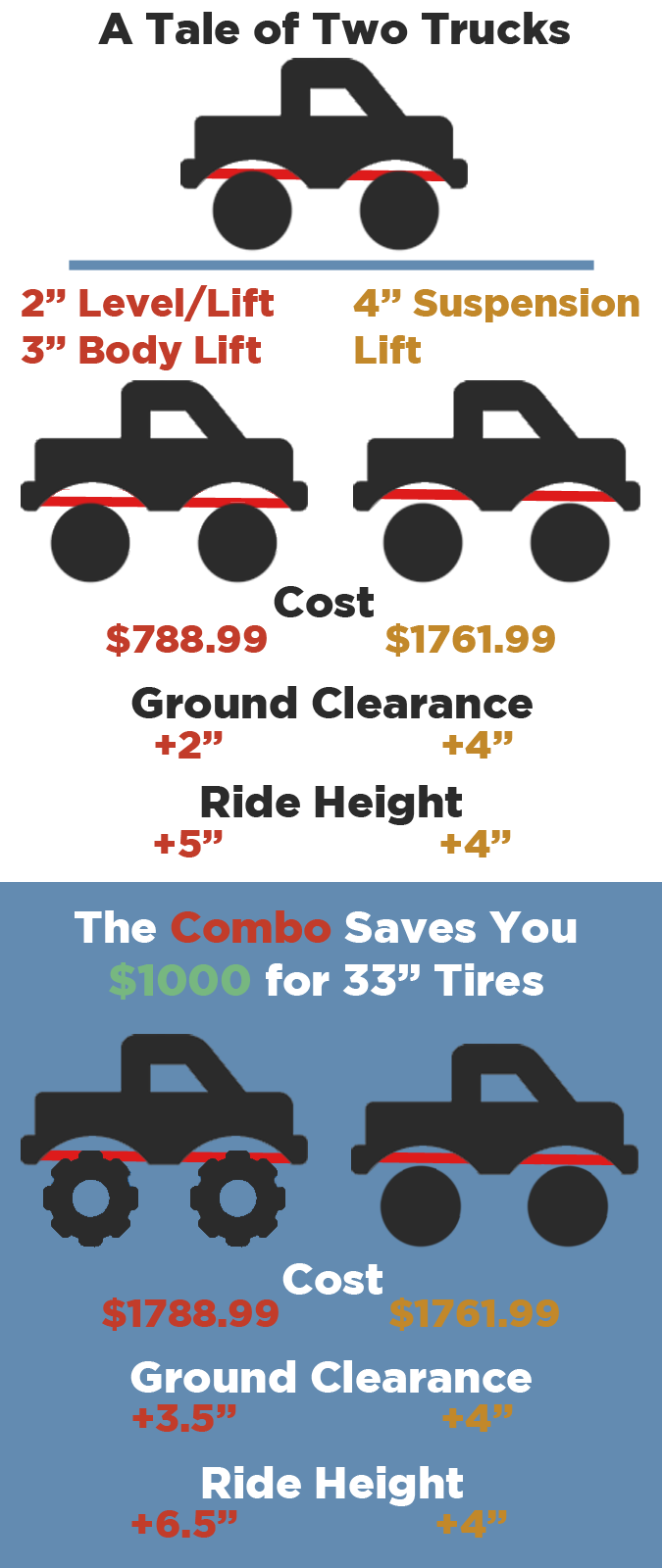
*This information is based on a 2016 Toyota Tundra model with 30″ stock tires.
Prices evaluated for:
Lift Combo
- Daystar Suspension (3″ Front | 2″ Rear) Lift and Leveling Kit
- Performance Accessories 3″ Body Lift Kit
- Set of four 33″ offroad tires at $250/tire
Suspension Lift
Brands
If you want to find a lift kit that fits your needs we have a few brands to suggest that test their kits rigorously to ensure the best handling and stability possible. All of these brands are designed and manufactured in the USA and are backed with a lifetime warranty by folks who know what’s expected of a lifted truck or SUV.
Full disclosure: We sell these brands, but we do so because they have a great reputation and they make high quality, dependable parts as evidenced by the numerous satisfied customers that we’ve had dealings with over the years. These are good places to start or finish your search for a lifting solution for your vehicle.
Daystar
Suspension Lifts, Body Lifts, Leveling Kits
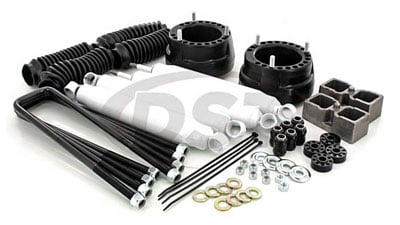
Everything to lift your Jeep, truck, or SUV. Simple kits with complete DIY instructions. Polyurethane components including control arm and leaf spring bushings.
Performance Accessories
Body Lifts, Leveling Kits
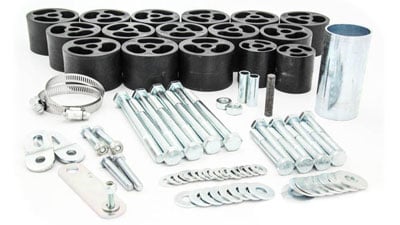
Designed and manufactured in-house. Premium Lift Systems combine a body lift and leveling kit for optimal lift and handling performance on a specific make and model.
In Conclusion
Hopefully you now have a really good idea of what the pros and cons are of the different lifting options that are available. Remember – lift as much as needed, but as little as possible and think about what your lifting goals are. If you want more ride height and bigger tires then a body lift is least expensive and causes minimal changes to how your vehicle handles. If you need some ground clearance for rough trails then a suspension lift is the ticket. A lot of times the best kit you can get is somewhere in-between, like a leveling/lift + body lift kit that balances cost, results, and handling of your vehicle.
From all of us here at DST: Ride Smooth (and tall), and Drive Hard.
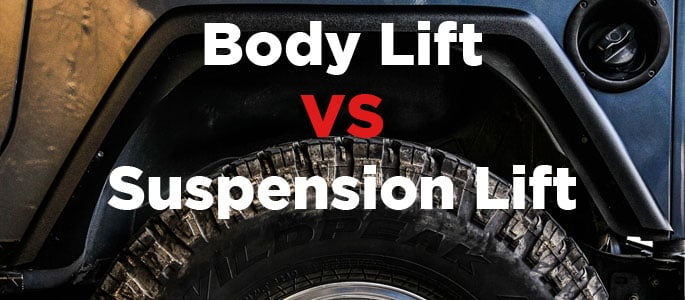
Brit
August 14, 2018 at 12:55 pmWhen comparing the body lift vs the suspension lift, whats the best way to figure out the maximum sized tire I could fit for my application in regards to both lifts?
Zach Davidson
August 16, 2018 at 2:08 pmHey Brit,
Most lift kits display the maximum tire size available post-installation either on the product page or in the instructions, specific to the vehicle model that the kit is made for. However, if you happen to find a kit that doesn’t give you this information, the easiest step would be to call the kit manufacturer who should have the information for your truck model regarding tire size.
If the kit manufacturer doesn’t have a maximum tire size listed then there’s no guarantee that a larger tire is going to fit.
That said, you can try to measure the available space by using your stock tires. With the help of a friend, you can turn your wheels completely in both directions, measuring the distances from the edges of the tire to the wheel well and suspension components for both the driver and passenger sides. It is also advised that you measure the width and backspacing of your stock tires compared to the suspension components. A general rule-of-thumb is to stay about 2 inches below the shortest measurement to make sure your new tires fit while lowering the potential for rubbing or understeer.
Hope this helps, Brit. Good luck with your lift.
jeremy harris
August 17, 2018 at 5:25 pmHow do I know which kit (Body lift or Suspension lift) is best for my application?
Zach Davidson
August 20, 2018 at 9:20 amHey Jeremy,
That depends on what you’re looking to get out of a lift and how much you’re willing to spend.
If you’re trying give your vehicle a more aggressive look or make a little extra room for larger tires, a body lift is going to get you great results at a much lower price than a full suspension lift. The added ride height that you gain will provide you with a great look but will not increase the ground clearance of you vehicle.
There are cheaper suspension lifts that work by adding spacers on top of your coil springs or underneath your rear leaf springs, typically for moderate trails that require a little extra ground clearance or larger tires. These carry all of the benefits of a body lift and some of a full suspension lift, while having less of an effect on your vehicle’s handling.
If you’re planning on taking your vehicle down the most intense trails that a stock vehicle can’t access then a higher priced, full suspension lift is for you. These kits exchange many or all of the factory suspension components and increase body roll which changes the handling of your vehicle but will increase ground clearance, make room for tires, and can provide greater flex or axle articulation.
Hope this helps.
Bear Lingle
August 24, 2018 at 12:25 pmWith a suspension lift will I have to have an alignment done after installation. Also my pickup has ABS and active suspension. Will a lift kit effect those systems. If I change my mind and decide to purchase a body lift how will effect the handling. My pickup will be higher and it will be easier for a roll over. Thank you.
Zach Davidson
August 31, 2018 at 10:01 amHey Bear,
Depending on which kit you buy, it is possible you will have to get an alignment done after installation. Many of the Daystar suspension lift kits that we sell minimize any changes on your OEM suspension and don’t require a post-installation alignment, but these are not full suspension lifts, which do require alignment. It all depends on the brand and quality of the kit you decide to go with, as well as the height of the lift.
Most lift kits will not affect your ABS, but your active suspension is a different story. Since an active suspension contains actuators, sensors and other complex components, an ordinary suspension lift isn’t going to work. When searching for a suspension lift, you will have to find a kit that is listed as compatible with your vehicle and active suspension components and will not effect the operation of your active suspension.
Since a body lift only elevates the cabin and interior components, the increase in center of gravity is much smaller than you would see with a suspension lift. The total increase in COG depends on the weight disbursements of your pickup, but a body lift shouldn’t increase it by much. Just remember that any lift increases the COG by some degree, increasing the chance for body roll and it’s up to you to determine how great that increase will be.
Thanks, Bear. Good luck with your lift.
David
August 30, 2018 at 1:57 pmI have a 2003 Chevy Silverado and was told that I could get taller spindles for the front and blocks to go on the rear. I’m guessing this would be considered a body lift? Would this require any alterations to the OEM suspension parameters on my truck?
Zach Davidson
September 10, 2018 at 9:41 amHey David,
A spindle lift actually falls under the category of a suspension lift. Since the spindle carries nearly the full weight of the vehicle, the sprung weight, it leads to a greater increase of the center of gravity and handling when lifted than a body lift would. A spindle lift works by rotating the mounting points downward on a new, taller spindle, providing a couple inches of lift. The effects that a spindle lift has on the OEM suspension parameters of your Silverado should be minimal, and it is typically an easy installation process compared to many other suspension lifts.
Now, if bigger tires is what you’re after and you want to keep the center of gravity a little lower than a suspension lift, you could try a body lift. Performance Accessories offers 2 inch and 3 inch lifts for the 2003 Silverado 1500. These will give you that taller look for much less and give you room for tires up to 35″ in diameter.
Hope this helps, David. Good luck with your lift.
steve widman
October 1, 2018 at 2:03 pmI have a 2014 chevy Silverado 1500 I put superspring on the rear for payload it raise the rear. I like to put spacers in front to even the body out level how do I figure out which size spacer to use? Do I measure the front end on ground then raised it with floor jack then measure the height after I raise it a certain height that should tell me what size of spacers I need? Before Front bumper 8.25 behind front tire on body 14” front of rear tire on body17” after I raise it to a certain height I came up with Front bumper 10.25 behind front tire on body 16” front of rear tire on body17.50 ? So I think I need a 2” spacer.
Josh Daniels • Post Author •
October 5, 2018 at 3:06 pmHey Steve,
Our ASE Certified mechanic suggested measuring as close to the front of the front wheel well as possible.
The limiting factor with these leveling kits is going to be the effect that the lift has on the suspension. The higher you go the more out of alignment some of your parts can become which can lead to premature wear and failure. We sell several Daystar leveling spacers for your truck and they are all 2in lifts, so i feel like you’re safe with that number. You’ll maintain the raked stance but the front will be 2 inches higher, which should level you out when you’re hauling.
Hope this helps Steve.
Kim
September 12, 2019 at 12:21 pmI’m trying to figure out the best combo or just straight suspension to clear 37’ tires and get some lift. It is currently sitting on a leveling kit and 33” tires. Any suggestions?
Josh Daniels • Post Author •
September 13, 2019 at 11:14 amHey Kim,
A lot of this depends on your vehicle and what kind of suspension you have.
MacPherson strut spacers, torsion bar keys, lift blocks and u-bolts, and taller spindles are options for different vehicles that give you ground clearance and room for those tires. A body lift will make room for the tires, add ride height, and is generally much less expensive than the other options. Most manufacturers (and our customer service folks) can tell you the max diameter tire size for a specific lift kit.
Those 37″ tires will give you about two inches of lift and ground clearance by themselves over the 33’s, so a body lift that allows you to install them would be the less expensive way. If a two inch body lift will give you the space for those tires then you end up with:
+4 inches ride height
+2 inches ground clearance
Basically, unless you’re looking for maximum ground clearance, a body lift is going to be best for keeping center of gravity lower and suspension angles in acceptable ranges. Plus it’s less dinero.
If you want to call or chat with our customer service folks and let them know your make and model they could be more specific about what actual kits are available and what route you might want to take. If you want to peruse on your own you can take a look at the brands we offer:
Daystar
Tuff Country
Performance Accessories
Thanks for the question Kim, and hope we helped with your decision.
Wiz
October 4, 2019 at 7:48 pmHave a 2018 Nissan Pathfinder not finding any solid info about how to lift it. Is it possible? Just looking to get a couple of inches for larger tires.
Josh Daniels • Post Author •
October 9, 2019 at 2:08 pmHey Wiz,
I just talked with the tech guys over at Daystar (who also have Performance Accessories and Tuff Country under their umbrella) and they said they don’t have any suspension or body lifts for the 2018 Pathfinder in development at this time.
If bigger tires are what you want, finding a body lift kit is going to be your best bet, though trimming of the panel around the wheel wells could also be required to make room.
Does anyone know of a lift kit fitted for the 2018 Pathfinder?
Sorry Wiz, and hope you find something that works.
Rod
January 24, 2020 at 11:33 amA very interesting and informative article. In our tests at https://www.vmn.com.au/ with a Toyota Hilux (similar to the Tacoma), the weight of a double cab body (excluding the bed) was 1390 lb (630kg) which is about 30% of the kerb weight.
A 2″ suspension lift increased the center of gravity by 2.36″ and a 2″ body lift increased the centre of gravity by 0.55″ with factory tires.
This change in center of gravity is still way less than the maximum specification quoted in body builder’s guides issued by some manufacturers.
We also found the increase in roll center from the combined lift of 4″ and even adding another 1″ or so for larger tires could easily be countered by changing the wheel offset/backspacing by 1″ to give a 2″ wider stance. (eg changing rim from +30mm offset to +5mm offset). So there is no real reason to be concerned about safety when lifting a 4WD. By the time you grab some new rims to fit your bigger tires, you are probably safer than when you started!
Keep up the good work guys!
Josh Daniels • Post Author •
January 28, 2020 at 10:41 amHey Rod,
Thanks for the information about the Toyota Hilux! We don’t see many of those in Texas 🙂
You’re right about using wheel offset and backspacing to widen the base and reduce the body roll that an increased center of gravity causes. In this article we were trying to offer solutions for lifting and upgrading wheels and tires on a budget and staying close to the factory settings.
In the end how someone chooses to lift should be determined by what their end goals are – Bigger tires, taller ride height, maximum ground clearance, etc.
If you want to go all out then you can get the 7 inch suspension lift and make up for the center of gravity and ride differences with other additions, but your total bill is going to be quite a bit higher.
Stacking a moderate suspension lift with a body lift can produce a taller ride height, extra clearance, room for a wheel/tire upgrade, and your body roll and other ride characteristics are minimally affected. All this for a much lower cost than a taller suspension lift.
Thanks again for sharing that information on the Hilux!
Have a good one Rod.
Steve A.
February 14, 2020 at 1:47 pmHi Josh –
First, thank you very much for this article. For folks like me who are about as mechanically inclined as a tree stump, this made a lot of sense.
I have two 4Runners, an 01 and 09. I would like to get some advice on the 09. With this vehicle, I do soft sand beach driving for fishing on the outer Cape. I have to air down to about 8 PSI. My 09 is stock with a noticeable rake. My goal is to do as little as possible to accomplish my objective. First, the rake is problematic. I have a brush bar on the front and with the deflation, my front end ground clearance is pretty low. I’d like to level and increase my ground clearance. Right now, the T4R is listed as having a 9.1″ with stock P265/70R16.
My goal is to have a level truck with an added 1-2 inches of ground clearance. Money is not my concern (I’d be okay dropping 2k). My concern is doing too much and ruining the dynamics of the design. Additionally, my state law is that any lift increase for my vehicle cannot exceed 3″ in combined body/suspension/tire lift (they have a formula). You had mentioned body lift, suspension life, and cheaper suspension lifts – all appear to be in play in some combination or the other.
I have a window of opportunity to do this modification. What do you recommend? I have no issue with you touting your product. I’d rather get the advice and product from the same source so that a comprehensive update is done and no corners are cut.
Any and all suggestions would be greatly appreciated.
v/r
Steve
Josh Daniels • Post Author •
February 18, 2020 at 4:00 pmHey Steve,
Glad you found some useful information and thanks for the kind words!
If you’re rolling around in sand I’m going to assume we’re talking about a 4×4 so all the recommendations will be based on that assumption 🙂 For ground clearance increase we’re looking at a suspension lift or leveling kit or larger diameter tires (but since the tires are running on a low psi increasing their diameter may not have as much effect).
The deciding factor will probably be 1) how much you want to spend and 2) if you want bigger tires in the future. With that, you have a range of options, all of which are well under your price threshold.
A 2.5″ leveling kit (2.5″ front, 1.5″ rear) will fix the stance, give you ground clearance, and leave a little room for bigger tires per your state’s lifting parameters. An even more subtle approach would be a 1″ leveling kit in the front which would leave even more room for bigger tires but less initial ground clearance.
2.5″ leveling kit
1″ leveling kit
If you’re not planning on bigger tires in the future and want a higher end option there are 3″ suspension lifts (3″ front, 2″ rear) that come with new control arms to adjust for the change in geometry and premium shocks. The control arms in these kits have either ball joints or spherical joints depending on your preference. Our on-staff mechanic suggested going with these options since they include other components to offset the geometry changes.
3″ suspension lift (ball joint control arms)
3″ suspension lift (spherical joint control arms)
I should mention that any modification to the suspension is going to affect your handling. Center of gravity changes will increase body roll so turning can feel different than your stock settings. Also if you’re looking at bigger tires in the future then you’ll have to go a little lower on the lifts so you don’t overshoot your state parameters.
If you have any other questions about the kits or fitment to your specific 4Runner please feel free to contact us and talk to our on-staff mechanic Edwin for the nitty gritty. Remember to get fitment confirmed with any kit you decide to go with.
Hope this was helpful and good luck with the modifications Steve.
Matt
March 23, 2020 at 7:43 pmI’m about to change the cab mounts on my 2006 Chevy Silverado 1500 crew cab I want to use polyurethane bushing but I don’t want my truck to squeak or affect the comfort of my ride is that possible?
Josh Daniels • Post Author •
March 24, 2020 at 9:35 amHey Matt,
So with polyurethane suspension bushings the answer for squeaking is a layer of grease between the poly and any metal surface that needs to move. In the case of body mounts, which aren’t suspension bushings, the metal sleeve inside the bushing doesn’t need to rotate so you should not have to worry about squeaking.
That said, some folks have applied some grease between the bushing and sleeve during install and haven’t had any adverse affects. In these cases it’s usually good to go with what the manufacturer says and most if not all poly body mount kits do not come with grease and manufacturers do not recommend greasing them.
As far as the comfort of the vehicle is concerned it’s kind of subjective. Polyurethane bushings are more rigid than rubber so the potential for more “road feel” is high and almost all people will notice a difference in how their vehicle feels. Some people like the change, claiming they have a better feel for how their vehicle is handling, but each person is going to have their own take.
A big plus for Poly body mounts is that your cab should not begin to sag over time like it can with worn or crushed rubber mounts. Poly body mounts are pre-loaded to the height that the cab needs to sit because they don’t compress over time.
To wrap up, I will generally recommend polyurethane body mounts to folks who want to eliminate as much body roll from their vehicle as possible or those with work trucks, rough commutes, and weekend track or trail toys. They just last much longer and hold alignment much better. But if comfort and noise isolation are your number 1 priorities then you’re probably better off with rubber bushings.
If you have any other specific questions you can ask them here or contact our customer service folks through chat or over the phone.
Matt
March 24, 2020 at 8:03 pmJosh thanks for the info one of the main reasons that I was gonna go with is that stock cab mounts are like $600 and some change for the uppers and lowers and the poly ones are $210 for a whole kit the price is a tremendous reason why I was gonna go with them I’m right in the middle of doing a complete restoration of the truck and I’m gonna lower it like 2 inches and run 24 inch rims on it so Im already deep in to this thing for a lot of money was trying to save some by cutting down the cost a little bit but I want it to ride smoothly and not make me want to change them after because I don’t like the way they ride cause then I will be in a bigger mess because I will have to buy the stock cab mounts and be stuck with the Polly ones to I don’t want to make the wrong decision that’s all
Josh Daniels • Post Author •
March 25, 2020 at 3:03 pmAh, Ok.
Well if you’re lowering the suspension then you are already going to be affecting the comfort level of the ride. Adding stiffer poly body mounts on top of that and I can pretty safely say that you will notice a significant difference in how the truck feels.
Again, it’s subjective as to how much road feel is too much from person to person. The surface you’re driving on will make a difference as well (unpaved vs interstate). If you’re doing mostly city driving on well maintained roads the increased feel will be less pronounced.
If your biggest issue is comfort then the rubber bushings will keep the ride closer to the original feel, especially with the lowered suspension. Poly mounts will last longer so they’re a better investment over a long period of time, but you will get more road feel.
Hope this was helpful, and good luck Matt.
Ben Latzke
April 13, 2020 at 9:35 pmI have a 2005 Sierra SLT 1500 crew cab. I have an opportunity to get a brand new 3inch body lift kit from a friend for free as a gift, it’s Rough Country SKU: 203/204 but says it only fits 07-13. Is that completely true or could it be used on my 2005? Also I need new body mounts whether I get a lift or not. Would that make this kit he’s offering a good idea being it looks like it has most if not all body mounts included?
Josh Daniels • Post Author •
April 16, 2020 at 11:30 amHey Ben,
For your first question, we don’t have much experience with Rough Country so contacting them directly is going to be your best bet. I would imagine that they would say “the kit is only guaranteed to fit the indicated year models” which means they’re not going to accept responsibility if something goes wrong and they certainly won’t accept any warranty claims. Since that kit includes a leveling component if there is any difference between the design of the ’05 and ’07 year models you’re likely to run into problems. You could probably talk to Rough Country for a detailed reason, but there likely is a reason that they wouldn’t include the ’05 in their fitment for this kit.
As for your second question, the body blocks in this kit are meant to be stacked on top of the body mounts or bushings already on the vehicle. From the website they look like fiberglass/nylon blocks and if so they have ZERO give and you would have a heck of a bumpy ride if you tried running with just those hockey pucks.
Sorry Ben, but as sweet as that deal sounds I don’t think that kit is going to work out for you. Hopefully the Rough Country folks can let you know for sure.
cnorriswzcom
April 20, 2020 at 4:34 pmJosh, great article, very informative. I have a 2005 Jeep Wrangler (TJ) that I’d like to lift; part for looks, part for off-road handling. Stella (our nickname for her) is not my primary vehicle, I only put around 3000 miles a year on her for simple trips around town, night out and of course bouncing around in the desert four-wheeling. I’m thinking a 3-4″ lift, but I’m curious – would you recommend straight suspension or a combo lift? Also, what is the best 4″ suspension lift for a Jeep??
Thanks in advance!
Josh Daniels • Post Author •
April 21, 2020 at 3:38 pmHey CNorris,
Thanks for the compliments!
When it comes down to it determining which kit is right for Stella you should consider three things: Intent, Handling, and Cost.
If aesthetic is your main goal raising the ride height of a vehicle and making room for bigger tires with a body lift is a pretty simple and inexpensive process and (with a moderate lift) the handling characteristics of your Jeep won’t suffer drastic changes. If you want maximum off-road capability then a more complicated, extensive, and expensive suspension lift is going to be required and your Jeep will handle corners differently, more so the higher the lift.
Deciding what is best is a matter of degrees one way or the other and in your case it sounds like you want a little of everything. There are several options for reaching 3-4 inches of lift so I’ll give you the extremes on each end and a mid-line possibility.
(Before we go on I have to say that our recommendations are a little biased since we do sell lift kits from specific brands, but they have an excellent track record and are well made so naturally we think they’re the best. They are rigorously tested and meet with the highest standards or set them, so do with that information what you will) 🙂
* Ok, so at the low cost end a 3 inch body lift kit from Performance Accessories is pretty straight forward and even comes with DIY instructions if you are more mechanically inclined (it can be quite a project). It’s inexpensive and will raise the ride height, add room for bigger tires, and have minimal effect on handling. One plus with this kit is that there are no other modifications needed, like new shocks or control arms. It goes on and doesn’t change the suspension geometry.
* At the high end a 4 inch suspension lift from Tuff Country complete with all the bells and whistles including taller coil springs, adjustable track bar, premium shocks, and new control arms all around. It’s an all-in-one suspension makeover. You get improved off-road capability, ground clearance, tire room, and with all the modifications the handling will be pretty smooth. This is the highest end and there are variations of this kit that cost less by cutting down on some of the extras. Basically you get a ton, but you also pay a lot.
* A middle of the road option is a 3 inch suspension lift from Daystar that includes the longer shocks and track bar brackets you’ll need. This kit offers ground clearance, tire space, minimal changes to ride quality, and is in a nice price range. If the ground clearance is important to you then this is probably the best bang for your buck. (If you would like another inch of ride height there is a 3 inch suspension/1 inch body lift combo (4 inch total ride height increase) that is basically the same kit with a body lift included.)
There are other options that run the gambit between these three but this gives you a pretty good idea of the range. “Best” is kind of a relative term based on personal preferences but the 4 inch Daystar combo kit ticks all of the aforementioned boxes.
Hope this was helpful and if you have any other questions you can contact us here or chat/call our customer support folks. Good luck and stay safe.
Rafael
January 20, 2021 at 8:42 pmHello,
I need some information. I have a Toyota Hilux 2014 and want just to level the front in line with the back.
What is the height of the leveling kit that I need (front only) ? Do I need 1.5″ or 2″ to level the front in line to the back.
This is only for cosmetics, as I do not put too heavy loads on my truck.
Your help with the information will be highly appreciated.
Thanks.
Rafael.
Josh Daniels • Post Author •
January 22, 2021 at 12:10 pmHey Rafael,
The best way to find that information is to measure the distance yourself. This will give you the most accurate measurement and ensure that you get the result you’re looking for.
To do this start at the center of the rear wheel and measure to the bottom of the wheel well. Take the same measurement on the front and the difference between the two will be the size of the leveling kit you will want.
Hope this helps find you an answer and if you have more questions you can contact our friendly customer support team.
Anthony
April 11, 2021 at 1:09 amGreat blog, just might want to be more clear to the more novice enthusiasts. A suspension lift creates additional ground clearance on everything from the axle up, not everything as implied. Without larger tires the vehicle hasn’t gained any more clearance with the axle or differential. Or Lower Control Arms, Leaf Springs parts and shackles in vehicles that have them.
Josh Daniels • Post Author •
April 15, 2021 at 10:58 amGood call Anthony,
A suspension lift on its own increases the distance between the ground and the frame. So while this doesn’t increase the ground clearance of the axles and differential, or lower control arms in IFS setups, it does create a lot of room between the frame and ground. As you pointed out, larger diameter tires are the only way to raise the ground clearance of everything under the vehicle, so those who want to get into serious rock crawling will want to look at bigger tires.
Thanks for sharing the insight Anthony.
Gray Messier
June 19, 2021 at 4:22 pmI am a novice at this and trying to accomplish the following on a 2001 Chevy Tahoe LT 5.3L 4×4, stock vehicle except I added Nitto 265s: 1) lift/backspace/offset my vehicle enough to allow for 33in tires without rubbing, 2) improve ride quality (like a modern car if possible), 3) limit reductions in handling, safety, and otherwise, and 4) maintain as “stock” a look as possible (I intend to keep my stock 16in wheels if possible). I don’t have any ground clearance goals, but am happy to have additional clearance from this suspension upgrade. I also understand this may require modifications to the frame, brakes, existing suspension system, etc.
Every shop I have called in Atlanta has either said “crank your torsion bars” or “we can only do a 6″ lift kit”. It seems I should be able to accomplish my goals with a 2.5-3in lift and I know a torsion bar crank will significantly reduce ride quality. I also think a 6″ lift kit would look extremely obnoxious on my vehicle and I am trying to be as subtle as possible. Do you have any recommendations for a suspension system that could help me accomplish my goals and/or an installer in the Southeast (preferable GA), that could implement that upgrade?
There is no limit to my budget for this, and I have explored coil over conversions, lift kits, leveling kits, etc. but no one seems to have a clue in my city outside of the above mentioned solutions. Thank you in advance for any help you can offer on this! – Gray
Josh Daniels • Post Author •
June 22, 2021 at 3:14 pmHey Gray,
So you have some conflicting goals, in that raising ground clearance with larger diameter tires is going to affect handling characteristics (even if its just by a small degree). That said the only thing you need to make room for larger diameter tires is a body lift which, incidentally, is the option with the least negative effects on ride characteristics.
Really the only limiting factor for bumping up to 33in tires should be clearance of the wheel wells. Moving from 30 to 33 is only decreasing the distance between the tire and the trim on any side by 1.5 inches. Now the width of the tires you decide to upgrade to will be another factor that might require offsetting.
There is a 3 inch body lift kit which would provide the vertical clearance in the wheel well, though you would still need to check the horizontal clearance. Added bonus – this kit doesn’t alter suspension geometry or factory stability control so your ride should be very similar with some differences once you get bigger tires. This kit comes with instructions and can be accomplished in the home garage, so a shop should have no trouble. Worst case scenario you would need to do a little trim work to prevent rubbing, but this is one of the best options for ticking most of your boxes. There are other options including taller body lifts or suspension lifts that can become as expensive or complicated as you desire, but this would be the most subtle. If you want more details about the kit or fitment feel free to contact our customer service folks.
Hope this was helpful and good luck with the lift.
Derrik
September 6, 2021 at 3:32 pmHi!
I own a 2012 Ford Expedition El in UAE, here we do sand bashing, deep sand driving, I have currently 33 inch tires, I was planning on inserting rough country 2inch or Traxda 2.75 inch spacers, I will be installing 35 inch tires for increase in ground clearance. I wanted your advise if the spacers are safe for serious off-roading as I don’t want to spend much for suspension and change the ride quality as it is a family car too. Thank you
Josh Daniels • Post Author •
September 7, 2021 at 9:27 amHey Derrik,
One of the ways of confirming how durable lift kits are is to check on the warranty. If the manufacturer backs the kit for life you can feel relatively confident that it’s going to last.
One important note: Be sure to check that you will get enough clearance for the new tire size. Some lift kits are actually leveling kits so a 2 inch lift in the front might be a 1 inch lift in the back.
Hope this helps and good luck on the lift.
Bruce D Campbell
May 21, 2022 at 5:32 pmI have a 2018 ram 1500 4×4 and I want to gain 3 inches of ground clearance on the front of my truck. I have a front mount motorcycle hitch that currently has on 5 1/2 inches of clearance.
Josh Daniels • Post Author •
May 24, 2022 at 8:36 amHey Bruce,
We don’t carry a 3+ inch lift kit for that make and model but there are some out there. A kit like that is going to mean longer knuckles or new control arms to compensate for the change in suspension geometry which also changes the handling of the vehicle in addition to being very expensive.
If you can get away with a 2 1/2 inch lift in the front then a front leveling kit would be a much cheaper option that would also maintain acceptable suspension geometry changes, keeping the feel and handling of the vehicle the same.
Hope this was helpful and good luck.
Leenard Solar
March 9, 2023 at 9:51 amis there a difference in ride and in cargo limit in a pick-up if I want to put a body lift?
Josh Daniels • Post Author •
March 15, 2023 at 7:42 amHey Leenard,
A really tall body lift could have some affect on the ride, but since only about 20% of the weight of the vehicle is raised with a body lift the center of gravity and the body roll characteristics are not changing drastically. With a body lift higher than 2-3 inches you would be more likely to notice some difference in the feel of the ride.
Cargo limit should not be affected as far as the amount of weight, but again, with a super tall lift you may need to take care with a heavy payload just by virtue of the bed being raised and the load with it. This is also assuming that the manufacturer did their job with R&D and is using quality materials.
If you are looking for a body lift we peddle Performance Accessories body lift kits that are Made in the USA and have a proven track record of quality and dependability.
Hope this was helpful and good luck with the lift.
Vamtxoos hawj
July 22, 2023 at 10:54 amHello there.
I have used a BDS Leveling 3 inches front and 2 inches in the rear suspension on a 2020 Toyota Tundra Platinum crew. I just want to know that, I am using my retail original rim from the manufacture, it’s a 275/65-r20. The original rims said 8E. What actual tire sizes will fit the rim and if I am buying 33 / 35 inches 285/65-R20 or 295/60-R20, do I have to modify my truck? What kind offset of rims can I use if I plan to use +18 or -18? I would like to have the tires half or 1 inch outside.
Josh Daniels • Post Author •
July 28, 2023 at 8:15 amHey Vamtxoos,
With the lift you already have you shouldn’t have a problem with 33in tires but 35s may require some modifications to avoid rubbing. You would need to check with the individual wheel manufacturer to get the most reliable answer about fitment with your rims.
The negative offset you mentioned would push your wheels outside the wheel well, but this can come with some issues like a wider profile or rubbing, not to mention that it is illegal in some areas so be sure to check.
Hope this was helpful.
Tom Vaughan
August 6, 2023 at 8:45 amVery informative article
If I put a 2.5-inch Body Lift only on my 2016 jeep 4dr Wrangler, will I have to do any other modifications. I have read on some forums that a motor mount lift bracket MAY be required, and transfer case linkage adjustments MAY be needed. What does “may be” needed mean, and how do I know if I do? Most of the kits I have looked at don’t or say anything else is required.
Thanks for your help,
Tom Vaughan
Josh Daniels • Post Author •
August 11, 2023 at 9:05 amHey Tom,
The kits we sell that fit your vehicle do not come with any bracketry for the motor mount so I don’t believe it is a necessary addition. That said, there could be modifications or other considerations that would make that bracket necessary. Best bet would be to contact the kit manufacturer directly and ask them or reach out to someone who has installed a 2.5 inch body lift on a 2016 Wrangler and see what their experience was like. Good luck with the install!